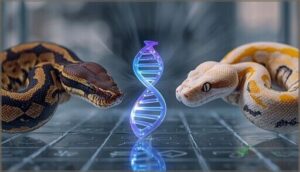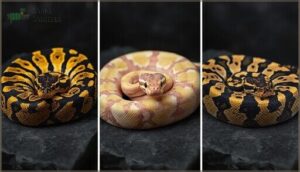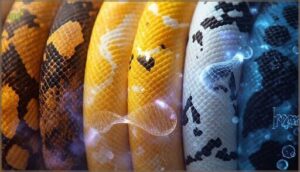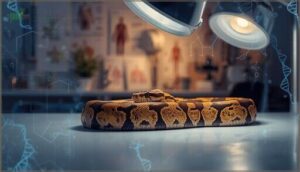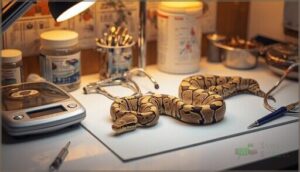This site is supported by our readers. We may earn a commission, at no cost to you, if you purchase through links.
The vibrant yellows of a banana ball python or the ghostly whites of a leucistic morph come with an invisible price tag—one written in the snake’s DNA. While the ball python breeding industry has produced over 6,000 documented color and pattern variations since the first captive-bred albino emerged in 1992, not every genetic mutation results in a purely cosmetic change.
Some morphs carry neurological disorders, skeletal deformities, or compromised immune function that can greatly impact quality of life. Understanding ball python genetic mutations and health isn’t just about predicting what hatchlings will look like; it’s about recognizing which breeding decisions create animals that thrive versus those that merely survive.
The difference between a responsible breeding program and one that prioritizes appearance over welfare often comes down to knowing which genes affect more than just pigmentation.
Table Of Contents
Key Takeaways
- Some ball python morphs—including spider, champagne, super cinnamon, and super sable—carry documented genetic disorders like wobble syndrome (affecting 100% of spider morphs), spinal kinking, and craniofacial deformities that compromise quality of life regardless of husbandry practices.
- Responsible breeding requires pre-breeding veterinary screening, genetic testing through shed-based DNA analysis (98% accuracy), and strategic outcrossing to unrelated bloodlines to reduce hereditary defects from 15% down to under 3%.
- Environmental issues during incubation—like temperature spikes above 92°F—can cause deformities that mimic genetic disorders, so you’ll need to distinguish between incubation-induced problems and true morph-linked conditions when evaluating hatchling health.
- Ethical breeding prioritizes genetic health and animal welfare over visual appeal, meaning you should avoid high-risk pairings that produce lethal combinations or severe neurological issues, even when market demand favors those morphs.
Ball Python Genetics and Morph Variations
Understanding ball python genetics opens the door to appreciating the stunning variety of morphs available today, but it also helps you make informed decisions about health and breeding. The inheritance patterns that create these color and pattern variations follow predictable genetic rules, though the outcomes can sometimes surprise even experienced breeders.
Let’s break down the fundamental principles that govern how traits pass from parent snakes to their offspring.
Basic Genetic Principles in Ball Pythons
Understanding ball python genetics starts with grasping how traits pass from parents to offspring through alleles—the building blocks of inheritance. You’ll encounter three mutation types: dominant, recessive, and co-dominant traits, each producing distinct phenotype expression patterns. Understanding how heterozygous genes work is key to predicting morph outcomes.
Here’s what shapes genetic outcomes:
- Each parent contributes one allele per gene
- Punnett squares predict offspring probabilities
- Homozygous individuals carry two identical alleles
- Heterozygous carriers possess different alleles
- Genetic terminology clarifies breeding expectations
Dominant, Recessive, and Co-dominant Traits
When you’re working with ball python genetics, you’ll see three inheritance patterns that determine breeding outcomes. A dominant gene produces visible traits with just one dominant allele—no super form exists. Recessive inheritance requires two recessive alleles for expression, while codominance creates distinct co-dominant phenotypes in both heterozygous and homozygous states.
The molecular basis affects how these mutations express in your breeding projects. Some breeders also focus on pattern disruption traits to create unique morphs.
Common Genetic Morphs and Their Origins
The albino morph, first bred in 1992 by Bob Clark, launched the ball python morphs revolution. Piebald history stretches to 1966, though genetic confirmation came in 1998. Axanthic genetics followed in 1997 as a simple recessive trait.
These early discoveries—originating from wild-caught African snakes—established foundational genetic mutations affecting coloration and pattern. Today’s morph combinations exceed 4,000 variations, built on these original genetic traits.
Genetic Variants Affecting Color and Pattern
What drives these thousands of morph combinations? Genetic mutations in key pigmentation genes—TYR, OCA2, TYRP1, and EDNRB2—control melanin loss, coloration, and patterns.
Community science using shed skins has revealed allelic complexity: Yellowbelly morphs show five different alleles creating phenotype variability from nearly white to subtle pattern inheritance changes.
These molecular discoveries explain how color variations arise and predict breeding outcomes.
Health Implications of Genetic Mutations
When you’re working with ball python morphs, understanding the health side of genetics isn’t optional—it’s essential. Some mutations come with documented medical conditions, while others carry risks that only show up under certain circumstances.
Let’s look at the most significant health implications you need to recognize and manage in morphs.
Morph-Linked Disorders (e.g., Wobble Syndrome)
Some ball python morphs carry a hidden price tag—neurological issues that last a lifetime. Wobble syndrome, for instance, affects 100% of spider morphs, causing head twisting, impaired coordination, and feeding difficulties due to malformed inner ear structures. Genetic screening and community awareness are essential to address these morph-linked disorders.
| Affected Morph | Wobble Prevalence | Anatomical Correlates |
|---|---|---|
| Spider | 100% (universal) | Malformed semicircular canals, abnormal sacculus |
| Champagne | Variable severity | Similar vestibular abnormalities |
| Hidden Gene Woma | Documented cases | Neural crest-associated defects |
| Super Sable | Reported symptoms | Inner ear structural deviations |
| Super Spotnose | Confirmed neurological issues | Statoacoustic organ malformations |
These genetic health issues raise serious ethical implications about breeding practices and animal welfare.
These genetic health issues raise profound ethical questions about whether aesthetics should outweigh animal welfare in breeding decisions
Eye and Cranial Deformities in Certain Morphs
Beyond neurological issues, certain morphs carry genetic predispositions to cranial malformations and eye deformities. Blue-eyed leucistics show “bug eyes”—enlarged, protruding globes—in up to 45% of individuals, while super lesser and super butter morphs regularly display abnormally large or misshapen eyes.
These morph-linked anomalies represent a severity spectrum of genetic disorders that directly challenge breeding ethics when aesthetics overshadow welfare.
Incubation Factors Vs. Genetic Defects
Although temperature anomalies and humidity effects during egg incubation can complicate embryo health, you’ll need to distinguish these environmental stressors from true genetic disorders.
Consider three critical diagnostic differentials:
- Incubation-induced deformities (missing eyes, kinked spines) result from temperature spikes exceeding 92°F
- Morph predispositions (Wobble Syndrome) persist regardless of incubation process
- Phenotype variations in hatchling health often reflect combined genetic and environmental factors affecting embryonic development
Recognizing and Managing Morph-Associated Health Risks
When you examine a ball python, you’re often looking past surface beauty to catch early signs of morph-linked disorders. Spider morphs universally exhibit wobble syndrome—head tremors and corkscrewing tied to inner ear malformations. Super cinnamon lines show spinal kinking in roughly 25% of hatchlings, while super sable morphs carry an 80% risk of craniofacial deformities.
| Morph | Primary Health Risk |
|---|---|
| Spider | Wobble syndrome (100% prevalence) |
| Super Cinnamon | Spinal kinking (~25% of hatchlings) |
| Hidden Gene Woma + Champagne | Lethal combinations (near 100% non-viable super forms) |
| Super Sable | Craniofacial deformities (~80% incidence) |
Managing these genetic disorders demands proactive screening. You’ll want to avoid high-risk pairings that produce lethal combinations or severe neurological issues. For snakes with mild symptoms, standard husbandry often suffices, but 20–30% with pronounced defects need specialized feeding protocols. Genetic counseling before breeding and transparent disclosure to buyers aren’t just ethical—they’re essential for reducing morph-associated suffering. Outcrossing to wild-type lines decreases inherited abnormalities by 30–40%, protecting future generations while maintaining genetic diversity.
Selecting Healthy Breeding Ball Pythons
Selecting breeding stock isn’t just about picking your favorite morph—it’s a medical decision that affects the health of your animals and their offspring. You’ll need to evaluate physical readiness, assess overall health status, and consider the ethical implications of your breeding choices.
Let’s break down the key factors that separate responsible breeding from guesswork.
Weight and Age Requirements for Breeding
You can’t rush reproduction—successful breeding hinges on meeting clear weight and age thresholds. Females need at least 1,200 grams and 2–3 years of maturity, while males should reach 700 grams by 8–18 months.
Prebreeding exams and clinical assessment confirm proper body condition and breeding readiness. Conditioning for breeding readiness minimizes weight loss and complications, directly influencing clutch viability and breeding outcomes.
Assessing Physical Health and Body Condition
Body scoring hinges on palpating muscle coverage along the spine and ribs—ideal pythons score 3 out of 5, showing muscle tone without visible ribs. Evaluating physical health and body condition means checking multiple indicators together:
- Scale quality: intact, unblemished skin with no ulcerations or retained shed
- Hydration status: firm white urates, not dark yellow from dehydration
- Vent health: clean with no swelling or discharge
- Behavior indicators: active tongue flicking and relaxed posture
Weight loss exceeding 10% in two months signals serious trouble.
Recognizing Signs of Stress or Illness
Beyond body condition, you’ll want to watch for behavioral shifts that reveal stress or illness: glass surfing, prolonged hiding at abnormal hours, or defensive postures signal environmental stressors.
Respiratory distress—wheezing, clicking breaths, mucus—appears in 100% of respiratory infection cases.
Feed refusal beyond two weeks, unexplained weight loss, or abnormal stool all warrant immediate veterinary attention.
Ethical Considerations in Morph Selection
Once you’ve confirmed health, you must confront the ethical considerations in morph selection. Breeder responsibility extends beyond survival—you’re shaping genetic health across generations.
Consider these welfare implications:
- Spider, Champagne, and Super Sable morphs carry 100% wobble syndrome risk
- Morph-linked disorders reduce quality of life regardless of husbandry
- Genetic diversity through outcrossing prevents amplifying hereditary defects
- Community influence increasingly rejects sales of neurologically compromised animals
- Market demand shouldn’t override animal welfare
Prioritize genetic health over visual appeal.
Genetic Screening and Responsible Breeding
Genetic screening isn’t just a nice-to-have in ball python breeding—it’s your best defense against passing on hereditary disorders that compromise welfare.
You’ll need to understand which morphs carry hidden risks, how to use genetic tools to make informed pairings, and why diversity matters more than producing the flashiest offspring.
Let’s break down the practical strategies that separate responsible breeders from those chasing trends without considering the consequences.
Avoiding Hereditary Disorders Through Screening
Because genetic screening gives you early detection value and reduces hereditary defects in your breeding program, you’ll want to use shed-based genetic testing before pairing your animals.
Breeder responsibility includes screening for morph-associated genetic disorders, which laboratories now detect with 98% accuracy.
Although screening cost impact exists, certified breeders report reducing genetic health issues from 15% to under 3%, while future screening tech continues expanding coverage of emerging mutations.
Outcrossing for Genetic Diversity
Once you’ve screened your breeding stock, responsible breeding practices demand outcrossing to unrelated lines. Pairing morph-carrying pythons with unrelated wild-types or different captive bloodlines reduces inbreeding depression, which directly decreases fertility and increases deformities.
Outcrossed offspring show better health outcomes, stronger immune function, and fewer morph-linked genetic health issues. This breeding strategy maintains genetic diversity and fosters long-term impacts that protect your animals’ vitality across generations.
Using Punnett Squares and Phenotype Predictions
With Punnett squares, you can predict breeding outcomes before pairing your animals. These tools calculate genotype probabilities for single or complex crosses, showing which alleles produce specific phenotypes.
Visual calculators simplify multi-trait predictions, letting you estimate morph percentages per clutch. Genetic verification through DNA testing confirms carrier status when phenotype alone won’t reveal it, giving you precision that facilitates healthier, more predictable breeding outcomes.
Best Practices for Health and Breeding Success
Successful ball python breeding isn’t just about pairing the right morphs—it starts with strong health management well before you ever introduce potential mates. From veterinary screening to nutritional conditioning, each preparatory step reduces the risk of complications like egg retention, metabolic disorders, and offspring with compromised viability.
Let’s examine the clinical protocols and husbandry practices that form the foundation of responsible, health-focused breeding programs.
Pre-Breeding Veterinary Health Checks
Before you pair your ball pythons, a thorough veterinary health check can catch problems that microscopy alone might miss. Prebreeding exams should include disease screening for Nidovirus and Cryptosporidiosis via PCR testing, reproductive evaluation through ultrasonography, parasite detection using fecal flotation, and baseline health assessment.
Don’t overlook neoplasia screening in older breeding stock—chronic conditions directly compromise reproductive success and clutch viability.
Nutritional Needs and Supplementation
Whole prey items meet all nutritional needs and supplementation requirements when sized appropriately—aim for 10–15% of body weight per feeding. Adults tolerate feeding frequency of 10–21 days, while juveniles require weekly meals.
Monitor weight trends to adjust prey size and avoid metabolic shifts from overfeeding. Routine supplementation isn’t necessary unless illness or reproduction demands clinical intervention.
Quarantine and Biosecurity Protocols
Proper quarantine protocols act as your first line of defense against disease transmission in your collection. New arrivals require 8–12 weeks of isolation, with wild-caught specimens needing up to six months due to elevated pathogen risk.
- Separate enclosures and airflow systems prevent cross-species risks and contamination between populations
- Handle established snakes first, then quarantined individuals, to minimize fomite transmission
- Use dedicated tools and disposable gloves per enclosure—this drops pathogen transfer rates over 90%
- Screen feeder rodents before introduction; unscreened prey contributes to 60% of bacterial contaminations
- Daily disinfection of high-touch surfaces in quarantine zones reduces bacterial load by 75%
Environmental Setup for Optimal Health and Breeding
Your breeding success hinges on replicating naturalistic environmental factors throughout the enclosure. Thermal gradients of 88°F–92°F at the basking zone and 75°F–80°F on the cool end drive metabolic function, while humidity control between 50% and 60% prevents respiratory disease.
Enclosure size of 4′ x 2′ minimum, substrate choice like coconut husk, strategic hides, and lighting needs including 12-hour photoperiods all improve reproductive readiness. Temperature cycling during breeding season further triggers hormonal cascades.
Frequently Asked Questions (FAQs)
Can genetic mutations affect ball python lifespan?
Yes—genetic disorders tied to certain morphs can shorten lifespan or reduce quality of life. While most ball pythons reach 20–30 years, mutation severity and morph-linked disorders like wobble syndrome may compromise longevity.
Are there DNA tests for all morphs?
DNA testing covers many single-gene morphs like Albino and Piebald, enabling carrier identification through genetic analysis.
However, complex traits and newly discovered mutations often lack established tests, presenting testing limitations with ethical implications for responsible breeding decisions.
Do morphs affect feeding behavior or appetite?
While anecdotal breeder reports suggest morphs like spider morphs eat better than banana morphs, no peer-reviewed research confirms morph appetite correlation.
Environmental factors, husbandry conditions, and individual variation overshadow any genetic influence on feeding patterns.
Can two different morphs produce healthier offspring?
Mixing genetically diverse morphs can reduce inbreeding depression and dilute harmful mutations, but it doesn’t guarantee healthier offspring.
Genetic outcrossing benefits depend on screening for disorders like wobble syndrome to avoid compounding genetic health issues.
How do breeders track genetic lineage accurately?
You’ll need a mix of digital record-keeping software, genetic sample testing from shed skin, manual documentation in spreadsheets, breeder collaboration databases, and pedigree visualization tools to track genetic bloodlines with clinical-grade precision.
Conclusion
Think of your breeding program as a garden: you can select for the most striking blooms, but if the roots are compromised, beauty won’t sustain life. Ball python genetic mutations and health are inseparable—every morph decision ripples through generations.
Prioritize animals that thrive, not just survive. Screen deliberately, breed ethically, and remember that vibrant scales mean nothing if the snake beneath them struggles to function normally.


